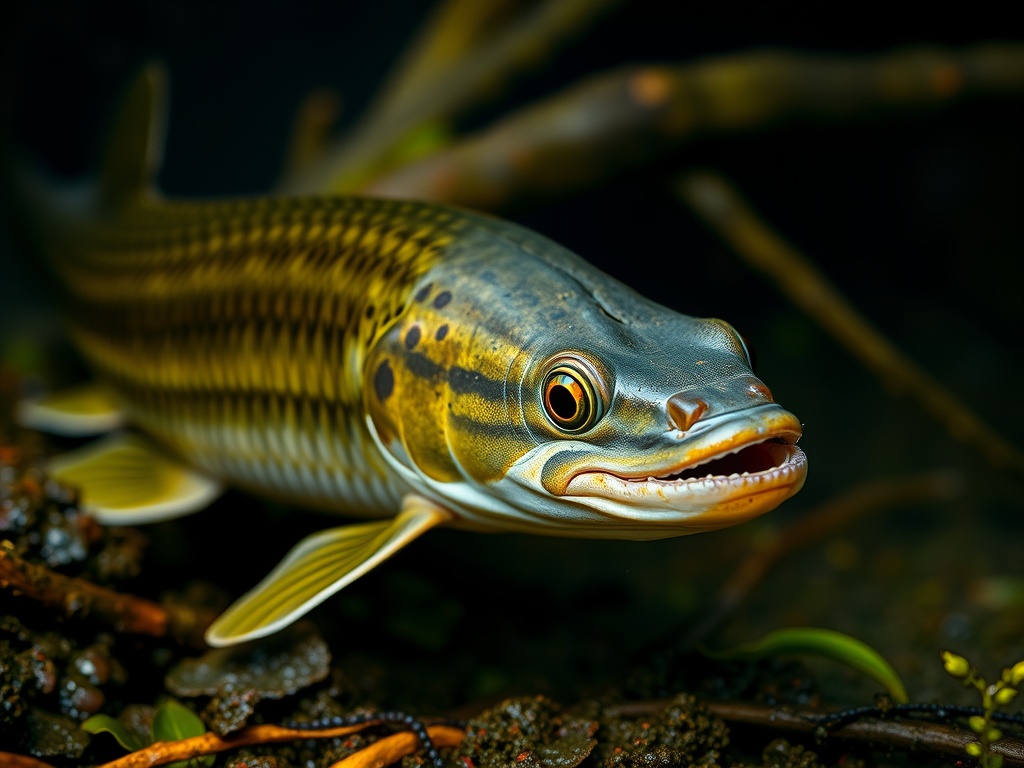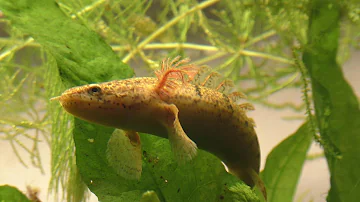
Bichir
Polypterus senegalus

Meet the Bichir
The Bichir is a primitive, elongated fish native to the freshwater systems of Africa, known for its distinctive armored scales and ability to breathe air. Often described as 'living fossils,' bichirs retain many ancient characteristics, including fleshy pectoral fins and external gills as juveniles. They are bottom-dwellers, typically active at night, and possess a keen sense of smell to locate prey. Bichirs can survive in low-oxygen environments thanks to their modified swim bladders, which function similarly to lungs.
Classification
Fish
Habitat
Freshwater rivers, swamps, and floodplains
Diet
Carnivore
Lifespan
10-15 years
Conservation
Least Concern
Weight
0.2-2.0 kg
📖Fascinating Facts
Ancient Lineage
Bichirs belong to a lineage of fish that dates back over 100 million years, making them true 'living fossils' of the aquatic world.
Air Breathers
Bichirs have a modified swim bladder that acts as a lung, allowing them to gulp air from the surface and survive in poorly oxygenated waters.
Nocturnal Hunters
They are primarily nocturnal, using their acute sense of smell and touch to hunt small fish, insects, and crustaceans at night.
📋Detailed Description
Polypterus senegalus, commonly known as the Senegal bichir or gray bichir, is a medium-sized, elongated ray-finned fish reaching up to 50 cm (20 in) in length, though most individuals are smaller. Its body is covered in thick, ganoid scales—diamond-shaped, hard, and enamel-coated—providing robust protection against predators and environmental hazards. The bichir's dorsal fin is distinctive, consisting of 7 to 9 separate finlets, each with a sharp spine, a feature unique among modern fishes. Its pectoral fins are fleshy and lobed, allowing for a degree of substrate 'walking' or crawling, reminiscent of early tetrapods. The head is broad and flattened, with a terminal mouth lined with numerous small, conical teeth adapted for grasping prey. Juveniles possess external gills, giving them a frilled appearance and enabling efficient respiration in hypoxic waters; these gills are lost as the fish matures. Adult bichirs retain a modified swim bladder that functions as a lung, allowing them to breathe atmospheric air—a vital adaptation for survival in oxygen-poor habitats. Their coloration is typically gray to olive, with subtle mottling that provides camouflage among aquatic vegetation and substrates. Bichirs are primarily nocturnal and rely heavily on a highly developed sense of smell, facilitated by large external nostrils, to detect prey and navigate their environment.
💡 Did you know?
Bichirs are among the few fish that can drown if they are unable to reach the water's surface to breathe air.
🔬Research & Sources
Wikipedia Summary
Bichirs and the reedfish comprise Polypteridae, a family of archaic ray-finned fishes and the only family in the order Polypteriformes.
Last Modified: 6/1/2025
🎭Behavior & Social Structure
Senegal bichirs are solitary and predominantly nocturnal, spending daylight hours resting among submerged roots, rocks, or dense vegetation. They are ambush predators, remaining motionless before lunging at unsuspecting prey, which includes small fish, crustaceans, insect larvae, and other aquatic invertebrates. Their hunting strategy relies on stealth and a rapid strike, facilitated by their muscular bodies and flexible pectoral fins. Bichirs exhibit a strong reliance on olfaction, using their external nares to locate food in murky or dark waters where vision is limited. Social interactions are minimal outside of breeding, and individuals may display territorial behavior, especially in confined environments. In captivity, they are known to be escape artists, capable of leaving the water briefly due to their ability to breathe air. Daily activity peaks at dusk and during the night, aligning with the activity patterns of their prey.
👶Reproduction & Life Cycle
Polypterus senegalus exhibits external fertilization, with breeding typically triggered by seasonal changes such as the onset of the rainy season, which increases water levels and stimulates spawning behavior. Males court females with a series of undulating body movements and fin displays. During spawning, the male wraps his anal fin around the female's genital opening to collect eggs as they are released, simultaneously fertilizing them. The female scatters the fertilized eggs among aquatic plants or substrate, providing some protection from predators. There is no parental care post-spawning; eggs hatch within 3 to 4 days, depending on temperature. The larvae are characterized by prominent external gills, which are gradually resorbed as the juveniles develop. Sexual maturity is typically reached within 2 to 3 years, depending on environmental conditions.
🛡️Adaptations & Survival
Bichirs possess several unique adaptations that have allowed them to persist since the Late Cretaceous. Their ganoid scales offer exceptional protection against predation and physical abrasion. The modified swim bladder, functioning as a lung, enables them to survive in hypoxic or stagnant waters by gulping atmospheric air—a trait rare among ray-finned fishes. Juvenile external gills maximize oxygen uptake in low-oxygen environments, a feature reminiscent of amphibian larvae. The lobed pectoral fins allow for limited terrestrial locomotion, enabling bichirs to move between water bodies during droughts or to escape predators. Their acute sense of smell compensates for poor vision, facilitating effective foraging in turbid waters. The ability to aestivate—enter a state of dormancy in moist mud during dry periods—has also been observed, further enhancing survival in fluctuating environments.
📚Research Sources
🎨Cultural Significance
Bichirs have intrigued humans for centuries due to their primitive appearance and unique adaptations. In some West African cultures, they are occasionally used as food, though they are not a staple. Their 'living fossil' status has made them popular in public aquaria and among hobbyists, symbolizing evolutionary resilience and the ancient lineage of vertebrates. In scientific research, bichirs have become model organisms for studying vertebrate evolution, particularly the transition from aquatic to terrestrial locomotion, due to their ability to 'walk' on land and breathe air.
🔬Recent Research & Discoveries
Recent studies have focused on the biomechanics of bichir locomotion, revealing that when raised on land, juvenile bichirs exhibit enhanced terrestrial walking abilities, providing insights into the evolution of early tetrapods. Genomic analyses have clarified the phylogenetic position of Polypteriformes as one of the most basal groups of ray-finned fishes, retaining many ancestral traits. Investigations into their respiratory physiology have highlighted the evolutionary significance of their dual respiratory systems. Ongoing research examines their developmental biology, particularly the retention and loss of external gills, and their potential resilience to environmental stressors such as hypoxia and climate change.
🎥Wildlife Videos

Secrets of the Polypterus
High quality footage of a Polypterus delhezi ( Bichir ). Looks at unique adaptations for survival, feeding, eating, and care. Beautiful ...
The Dave

SBKPH SHORT BICHIR DOCUMENTARY OFFICIAL TRAILER
James Reinier Jose

Bichirs, Albino Snakehead and Giant Gourami
Bichirs, Albino Snakehead and Giant Gourami.
Bill Goldberg

Bichir and Reedfish facts: kind of like eels | Animal Fact Files
A bichir (pronounced "bi*" + "sheer" *(as in "bit")) is a type of fish that looks unlike any other - well, except maybe the very closely ...
Animal Fact Files

Guardian of the Ancient Waters: The Story of Bichir
Discover the enchanting story of Bichir, the mystical guardian of the ancient waters in our latest animated tale, "Guardian of the ...
BAWAL HUNTER

Armoured Bichir ( Polypterus delhezi )
This ancient fish known as the Armoured bichir is a living fossil. It has some very primitive features not seen in any other fish.
The Dave
🌍Habitat Information
The Bichir typically inhabits Freshwater rivers, swamps, and floodplains environments. Bichirs have adapted to their environments with specialized features and behaviors.
Primary Habitat:
Freshwater rivers, swamps, and floodplains
More detailed habitat information will be available soon.
🛡️Conservation Status
The Bichir is currently classified as Least Concern. Conservation efforts are crucial for preserving this species for future generations.
Common Threats:
- 🏠Habitat loss and fragmentation
- 🌡️Climate change impacts
- 🎯Hunting and poaching
- 🏭Human-wildlife conflict
⚠️Threats & Conservation Challenges
Currently classified as Least Concern by the IUCN, Polypterus senegalus faces localized threats from habitat degradation, water pollution, and overfishing for the aquarium trade. Wetland drainage, dam construction, and agricultural runoff can reduce suitable habitats and water quality. While populations remain stable across much of their range, ongoing environmental changes and increased exploitation could pose future risks. Invasive species and competition with introduced fishes may also impact local populations. Conservation efforts focus on habitat preservation and monitoring of wild-caught individuals in the pet trade.
🔬Scientific Classification
Scientific Name
Polypterus senegalus
Classification Hierarchy
🔍 About Taxonomic Classification
Taxonomic classification is a hierarchical system used by scientists to classify and organize living organisms based on shared characteristics and evolutionary relationships.
The system moves from broad categories (Kingdom) to increasingly specific ones, with each animal's scientific name typically consisting of its Genus and species.
📝Community Notes
Share your observations and insights about the Bichir with our community of wildlife enthusiasts.
Join Our Community
Sign in to share your observations and connect with fellow wildlife enthusiasts.
Sign In to ContributeNo community notes yet
Be the first to share your observations about the Bichir!
Explore Bichir
Select a tab above to learn more about this amazing animal.
📸Photo Gallery
No photos available for this animal yet.
🌟Discover More Wildlife
Continue your journey of discovery with more fascinating animals from our database
